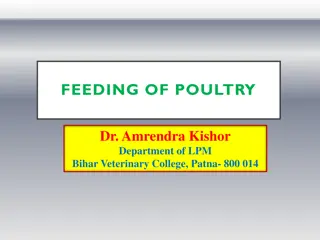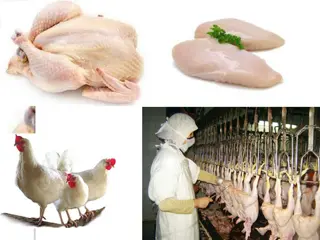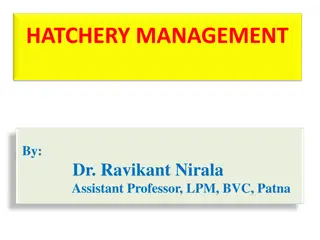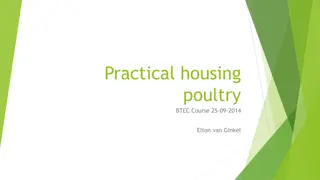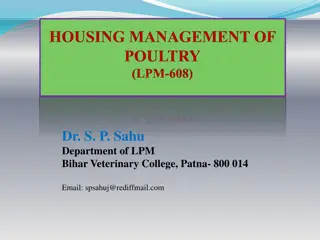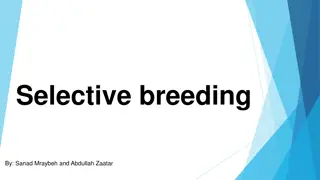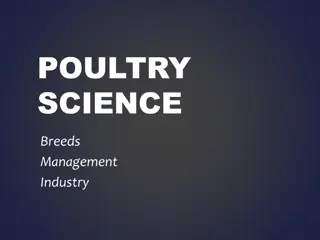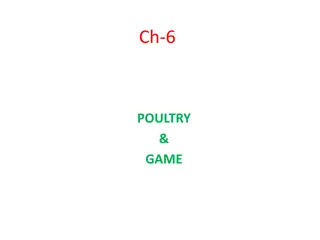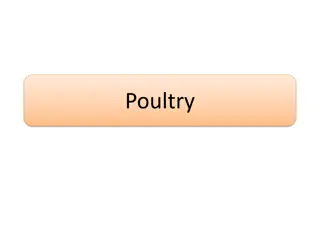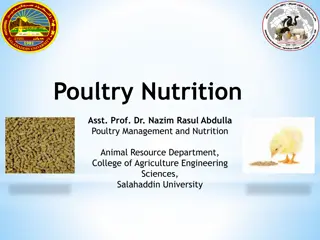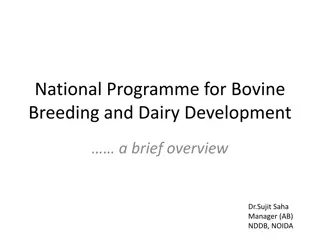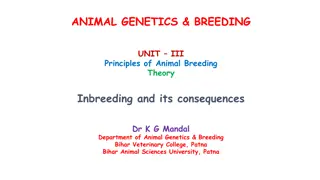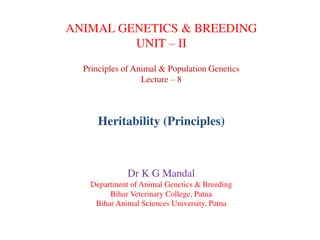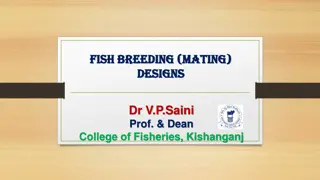Principles and Systems of Poultry Breeding: A Comprehensive Guide
Poultry breeding, led by experts like Dr. Suchit Kumar, involves purposeful selection and mating to improve size, weight, egg production, and meat quality. Environmental factors are crucial, and different breeding systems like inbreeding and line breeding play a role in genetic improvement. Continuous selection, proper housing, and introducing new stock are key for successful breeding practices.
Download Presentation

Please find below an Image/Link to download the presentation.
The content on the website is provided AS IS for your information and personal use only. It may not be sold, licensed, or shared on other websites without obtaining consent from the author. Download presentation by click this link. If you encounter any issues during the download, it is possible that the publisher has removed the file from their server.
E N D
Presentation Transcript
Poultry Breeding Prepared By-- Dr. Suchit Kumar Asstt. Prof. cum Jr. Scientist Department of Livestock Farm Complex Bihar Veterinary College, BASU, Patna-14
Principle of Poultry Breeding Breeding should be purposefully Breeder regulate the standard to which birds are to be bred. It may be for size, weight, egg Production, meat quality or combination of these factors. Breeding should be done from parents which conform as closely as possible to the required Standard In selection and mating, all the birds which fail to possess the desired standards should be discarded and never used for breeding The parents selected for breeding should be pure breeds For a successful breeding, selection must be practiced continuously and carefully, from hatching to maturity
Environment plays an important part in breeding. So a favorable condition should be created in respect of housing, feeding, sanitation and general care Pedigree breeding is an important practices wherein efficiency of matting can be measure. The selection and mating operation modified to ensure improvement. But this is possible only in well-established farms, requiring lot of technical expertise, and accurate mating and breeding rewards Introduce new stock into your breeding program to prevent inbreeding and weakening your flock
SYSTEMS OF BREEDING The mating system and selection both are require for bringing genetic improvement of livestock. The mating systems have been regulated on the basis of genetic relationship of the mates that is whether the mates are genetically related or not. The mating system can also be classified on the basis of phenotypic similarity or dissimilarity of the mated individuals. When mated individuals; Alike in phenotype - Increases in homozygosity Unlike in phenotype - Increases in heterozygosity, The reason is that the genetic make-up of the zygote produced by mating of alike or unlike mates is influenced
The breeding systems can be classified depending on whether it is aimed to increase homozygosity or heterozygosity. Inbreeding It is defined as mating between individuals which are more closely related to each other than the average relationship between all individuals in a population. Inbreeding can be consistently carried out for several generations. There are following methods: a) Close inbreeding: The close breeding is the mating of more closely related individual like parent - offspring mating ( sire-daughter, son-dam) P1 P2 F1 F2 F2
The line breeding is taken in two ways. The first way is the mating of animals which are more distantly related like cousins mating. In This system the rate of inbreeding is less than close breeding and hence the inbreeding depressions is less.
The second way is the mating of animals in such a way that their descendants are kept closely related to an outstanding animals. In another words, the descendants are mated to outstanding animal(Sire) upto 3-4 generation Sire G4 Dam G3 G2 G1 As line breeding is practices to retains or concentrates the genes of an outstanding animal, it should be carried out in better than average herds particularly when it is not possible to get good quality sires from outside.
Crossbreeding The mating of animals from different established breeds is called crossbreeding. The progeny produced is called crossbred.
Types of Crossbreeding Composite crossing to produce synthetic breed Regular or Systematic crossing A. Specific crossing 1. Two breed crosses 2. Three breed crosses 3. Four breed crosses Rotational Crosses 1. 2 Sire breeds 2. 3 Sire breed
Composite crossing Development of a composite or synthetic breed results from the crossing of two or more existing breeds. This is alternate to regular crossing. It is done by producing one or few crosses between two or more population to produce a single population having genes from each of the population . This single population of a mixture of various crossbred population is called a Synthetic composite First, composite breeds can be developed to take advantage of the relative strengths of existing breeds. The second advantage of a composite breed is that it maintains hybrid vigor over time. Hybrid vigor is the added advantage realized by crossing breeds or lines. When genes from one breed are paired with genes from another breed, bad (recessive) genes tend to be masked by good (dominant) genes.
In most situations, it is not feasible to maintain an F1 herd; so, we usually lose some of the advantages of hybrid vigor over time. Traditional methods used to maintain hybrid vigor require multiple breeding pastures and sire breeds. On the other hand, a properly designed composite breed will maintain most of the hybrid vigor present in the F1 even though the composite is mated like a purebred breed. The amount of hybrid vigor lost (relative to the F1) is a function of the probability of genes from the same parental breed pairing at any location on any chromosome. Conversely, the amount of hybrid vigor maintained is a function of the probability of genes from different breeds pairing. In a composite breed, the probability that genes at any locationcome from different breeds is determined by the number and proportion of breeds used in the development process.
Cross-breeding In many regions, local indigenous and commercial genotypes have been crossed in attempts to provide birds that are tolerant to local conditions while also capable of reasonable performance. In nearly all cross-breeding programmes, the cross-bred bird exhibits considerably better egg production and/or growth rate than the indigenous breed parent, but problems can be encountered with: Loss of broodiness in hens, making them incapable of reproducing naturally; The need for maintaining separate parent lines/breeds and for the annual replacement of F1 cross-bred chicks; The need for additional inputs (particularly feed) to achieve the birds genetic potential for production; A change in appearance and type , which affects the birds acceptability to farmers and the consumers of poultry eggs and meat; Erosion of the genetic resource.
The following methods of mating are generally used: [A] Natural mating Pen mating Flock mating Stud mating Shift mating. [B] Artificial insemination
Pen Mating Usual method of mating used for pedigree hatching. A group of hens are allowed to mate with a cock in a pen. The mating pens are of 8ft x 6ft size. The male to female ratio is 1: 10 or 12 for light breeds and 1: 8 or 10 for heavy breeds. The fertility is lower in this mating compare to flock mating due to preferential matings i.e. a male may mate more frequently with certain females than with others. The preference for mating is generally attributed to plumage colour etc.
Flock Mating It is mass mating system wherein two or more males are mated with several females housed in single pen. Male to female ratio is generally higher in this method i.e. one male for 12 to 15 females of light breeds and 10 to 12 females of heavy breeds. From pedigree hatching point of view, the eggs cannot be identified for their parentage. Under this system, sometimes the aggressive males scare away other males preventing them from mating. Such aggressive males should be removed from the flock. This method also provides an opportunity for the birds to mate with the mates of their choice whereas there is no such choice in stud or pen mating. The fertility is generally high and, therefore, much desirable for producing chicks meant for commercial purpose.
Stud Mating In this type of mating the male is kept separately in coop or pen (2 ft * 3 ft size). The females are picked up from the pen one by one and put into the coop. After the mating is accomplished, another female and so on replace the female. In comparison to flock or pen mating, it involves more work and labor. More offspring s can be obtained from sire of high merit. By this method it is possible to mate one male to many females. To ensure good fertility, the hen should be stud mated at least once a week.As compared to flock or pen mating this method results in higher fertility. This method of mating can also be employed if the birds are kept in the cages.
Shift Mating In this type of mating the sires are shifted in breeding pens. This method can be employed in breeding programs (family breeding) where the breeding value of more number of males needs to be tested for locating really superior males. At the same time by shifting the male, a female can be mated with several males and her breeding worth can be evaluated more precisely. The major hindrance in shifting of males in a breeding pen during the season is the problem of accuracy of the parentage of the progeny since the fertility is maintained for 2-3 weeks even after removing the cock. This difficulty may be overcome by discarding the eggs for one week after the change of males. The main advantage of this system is that a large number of males can be tested in a limited space. The pen mating doesn t differ from this system except the mates are shifted from one pen to another in a sequence.
B] Artificial Insemination Artificial insemination (A.I.) means the deposition of semen into reproductive tract of female by some means other than natural mating. It starts from the collection of the semen from the male and its evaluation in terms of motility, viability and concentration followed by its deposition into female reproductive tract. Sexual maturity in both male and female bird occurs at 18 weeks of age. One ejaculate of a male can cover up 20 female birds by using AI. Dose of semen is 100 200 million spermatozoa/insemination in 50 microliter volume. Poultry semen shows poor response for cryopreservation so AI is done as soon as semen is collected





